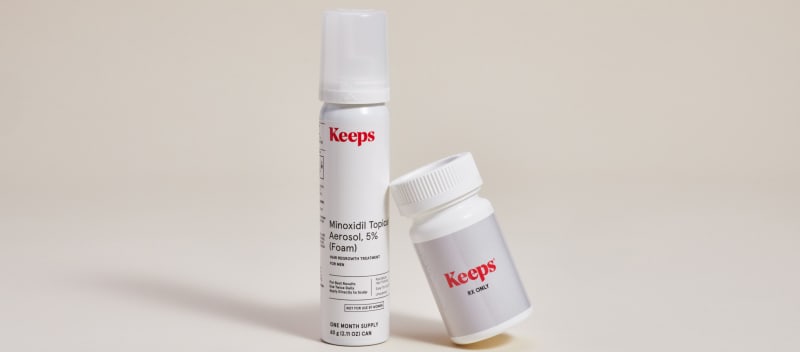Finasteride vs. Minoxidil: What’s Right for Me?

Losing hair? You’re not alone: two out of three guys will experience some form of male pattern baldness by the time they’re 35. That’s where finasteride and minoxidil come in, but what are they?
Finasteride and minoxidil are the two most prominent—and clinically proven—treatments for men’s hair loss. Although they both work to achieve the same goal (slowing down hair loss and promoting regrowth), they work in totally different ways. Let’s break down minoxidil vs finasteride:
What’s the difference between finasteride and minoxidil?
Finasteride (generic Propecia®) is a DHT blocker. DHT (dihydrotestosterone) plays a starring role in male pattern baldness; it’s a hormone that binds to men’s hair follicles and damages them, ultimately rendering them unable to grow new hair. Finasteride prevents hair loss by stopping your body from converting testosterone into DHT.
Minoxidil (generic Rogaine®) is a vasodilator. When applied to your scalp, it widens the blood vessels, facilitating the flow of blood to hair follicles. This increased blood flow, in turn, delivers more oxygen and nutrients to hair follicles, possibly promoting hair growth.
How do finasteride and minoxidil help treat hair loss?
Finasteride helps stop hair loss and grows new hair by blocking DHT.
Minoxidil doesn’t stop hair loss, but it does help grow new hair thicker and faster than before.
Finasteride and minoxidil (the only two FDA-approved products to treat men’s hair loss) have been proven successful at treating hair loss in men, according to multiple studies.
A five-year study on the efficacy of finasteride in men with androgenetic alopecia showed improvement in 90% of participants. A 120-week study of male subjects with androgenetic alopecia showed that minoxidil was superior to the placebo in increasing hair count, and the results were statistically significant.
What forms do finasteride and minoxidil come in?
Oral
Finasteride is a pill, which you take orally once a day.
Minoxidil also comes in a pill, which you take orally once a day.
Topical
Finasteride comes in a compounded gel, a two-in-one prescription hair loss treatment that combines both finasteride and minoxidil.
Minoxidil comes in many forms. As a topical treatment, you apply it to your scalp twice a day. It is available as a liquid solution, which you apply with a dropper, and as a foam, which you apply with your hands. Both forms are equally effective.
Minoxidil is also available as part of our doctor-formulated Minoxidil+ Hair Regrowth Spray. This is a compounded prescription solution, meaning it has multiple ingredients (hello caffeine, melatonin & tretinoin) supercharging minoxodil’s effectiveness in an easy once-daily application.
Can you take minoxidil and finasteride together?
Yes! Finasteride and minoxidil work through different mechanisms, so there is no risk in using both products at the same time. In fact, men who are experiencing overall hair loss and a receding hairline will often be recommended minoxidil and finasteride together.
So, which should you use?
Finasteride and minoxidil are different medications, and each serves a different purpose. Ultimately, combatting hair loss is a commitment—in order for the treatments to work, you need to use them daily.
Finding what’s right for you comes down to your dedication, your preferences, and what your provider thinks is the best solution to help you achieve the hair that you want.
Increase your chances of success by connecting with a Keeps provider who can help you pick the right approach for your needs and lifestyle.
Need help figuring out which treatment is right for you?
You can make your life easier by filling out a quick questionnaire for one of Keeps’ expert doctors to review. Once that’s submitted, the doctor will follow up with a recommended treatment plan and next steps.
The information provided in this article is not a substitute for professional medical advice, diagnosis, or treatment. You should not rely upon the content provided in this article for specific medical advice. If you have any questions or concerns, please talk to your doctor.
Finasteride Tablets 1mg, Rx only, treats male pattern baldness in men only. Finasteride may cause side effects including some form of sexual side effects, such as less desire for sex, difficulty in achieving an erection, or a decrease in the amount of semen released during sex. Other potential side effects of Finasteride include swelling or tenderness in the breasts or pain or fluids leaking from the nipple, pain in the testicles, inability to urinate, or depression. If you would like to learn more about Finasteride, please see the full prescription information, here. You are encouraged to report negative side effects of prescription drugs to the FDA. Visit MedWatch or call 1-800-FDA-1088.
If you’re experiencing a mental health crisis, please call 911 or go to your nearest emergency department. If you are contemplating suicide, call 911 or call/text the National Suicide and Crisis Lifeline at 988. These services are available 24/7.
Minoxidil Solution 5%, intended to treat male pattern baldness may cause side effects, including chest pain or palpitations, dizziness, skin rash, blisters or itching, sudden weight gain and swelling of hands and feet. If you would like to learn more about Minoxidil Solution 5%, please see prescribing information here. You are encouraged to report negative side effects to the FDA. Visit MedWatch or call 1-800-FDA-1088.
Individual results may vary. Important drug safety and benefits information on Minoxidil+ Hair Regrowth Spray (minoxidil 5%, 0.2% caffeine, 0.1% melatonin, 0.01% tretinoin), an Rx only compound drug, can be found here. Minoxidil+ Hair Regrowth Spray has not been FDA-approved or evaluated for safety, efficacy, or quality but can be used to treat male pattern baldness, and may cause side effects including chest pain or palpitations, dizziness, skin rash, blisters or itching, sudden weight gain and swelling of hands and feet. You are encouraged to report negative side effects of prescription drugs to the FDA. Visit www.fda.gov/medwatch or call 1-800-FDA-1088.